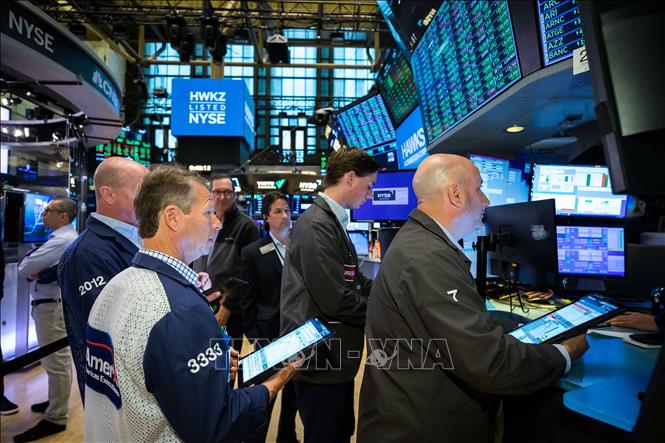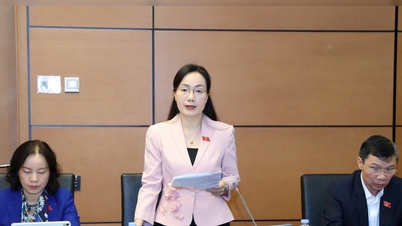
The green color just "flashes over and then goes away"
At the start of the new week, hopes of a rare return to green were sparked when the market received positive signals from the cooling of US-China trade tensions. However, strong selling pressure quickly drowned those hopes, pulling the VN-Index back into the red zone in the first session of the week.
A rare bright spot appeared when the index approached the strong support zone of 1,620 points. Strong buying pressure helped the market recover impressively, regaining the MA50 line - the 50-session average price line, often considered a milestone to confirm short- to medium-term trends. This development sparked expectations of a "second bottom". However, that confidence did not last long. The weekend session - also the day of portfolio restructuring of funds - became a whirlwind that swept away previous achievements, especially when the large-cap group was under strong pressure to correct.
Leading the decline were stocks of the Vingroup family (VIC, VHM, VRE) - a group that had been an important support for the VN-Index for many weeks - along with the "sluggish" performance of banking and securities stocks, making the market even more gloomy.
Last week, liquidity fell sharply, although some stocks remained stable. In contrast to the weakening of the bluechip group (large-cap stocks, leading the market), selective cash flow found its way to some midcap stocks (medium-cap stocks, often more flexible) as well as a few individual bluechips such asFPT , DGC, GAS, helping these stocks maintain a stable green color.
However, the overall picture still shows a high level of caution. The matched liquidity last week fell sharply, 30.3% lower than the 20-week average - a decline that clearly reflects the cautiousness of cash flow. At the end of the trading week from October 27 to 31, the VN-Index closed at 1,639.65 points, down 43.53 points (down 2.59% compared to the previous week).
The bright spot last week belonged to the technology - telecommunications group. Although the general index fell sharply, the market opening still leaned towards green when 14 out of 21 industry groups increased points. The technology - telecommunications group increased by 8.51%, textiles increased by 6.75% and industrial real estate increased by 6.23%. These were the 3 groups of stocks leading the increase in the week.
On the other hand, the real estate group decreased by 11.11%, the securities group decreased by 2.87% and the retail group decreased by 2.30%. These were the three groups with the strongest declines of the week.
Foreign investors cooled down their net selling last week, but cash flow remained cautious. Accordingly, foreign investors recorded a net selling of VND2,723 billion this week, a slight decrease compared to previous weeks. The stocks with the strongest net selling last week were MBB (VND1,276 billion), SSI (VND1,006 billion),ACB (VND836 billion). Meanwhile, foreign investors "aggressively" net bought FPT (VND1,928 billion), VPB (VND250 billion), HDB (VND238 billion).
In its weekly strategy report, Vietnam Construction Securities Joint Stock Company (CSI) assessed that the restructuring session at the end of the month had caused great pressure, but low liquidity showed that the market had not yet fallen into a sell-off state. VN-Index recorded two consecutive months of adjustment, falling 1.33% in October, thereby forming a clear adjustment trend on the daily, weekly and monthly charts.
CSI believes that the risk for new buying positions is high. This securities company expects the VN-Index to adjust to the support zone around 1,560 points in the coming month before cash flow returns more clearly. Accordingly, CSI recommends investors maintain a moderate stock proportion (50-60%) and patiently wait for the VN-Index to test this support zone before considering opening new positions.
Bao Viet Securities Joint Stock Company (BVSC) and SSI Securities Joint Stock Company (SSI) commented that the market is moving sideways and recommended that investors monitor the small and medium capitalization group.
According to BVSC, VN-Index is fluctuating in the range of 1,600 - 1,620 points to 1,705 - 1,725 points, showing a sideways state with the possibility of strong fluctuations at the two borders of this range. If this sideways trend is maintained in the first half of November, cash flow may shift to speculative stocks and small and medium capitalization stocks.
Meanwhile, SSI said the index is testing the support zone near 1,640 points, in the context of momentum indicators maintaining weakening signals. SSI said the 1,600 - 1,610 point zone is still an important milestone to confirm the larger trend of the market.
In fact, market developments show that the Vietnamese stock market ended October in a state of high caution. Investor sentiment was strongly challenged by international fluctuations, policy factors and portfolio restructuring activities. However, cash flows still showed clear differentiation, instead of complete withdrawal, thereby leaving open the possibility of technical recovery waves in the coming period.
In the context of short-term risks still present, the general recommendation of securities companies is to maintain a moderate proportion, strictly manage risks and observe market reactions around key support zones.
Wall Street says goodbye to October positively, Dow Jones has a long winning streak

Domestic cash flow is cautious and the market continues to be divided. In contrast, major markets in the world - especially Wall Street - show brighter colors.
The US stock market closed October 2025 on a solid upward trend, despite a volatile week marked by mixed signals from the US Federal Reserve (Fed), technology earnings reports and US-China trade negotiations.
In the trading session at the end of the week on October 31, all three major indexes increased slightly thanks to the strong pull from Amazon stock. The Nasdaq Composite index increased 0.61% to 23,724.96 points, the S&P 500 increased 0.26% to 6,840.20 points, and the Dow Jones increased 0.09% to 47,562.87 points. For the week, the S&P 500 increased 0.7%, the Nasdaq increased 2.2% and the Dow Jones increased 0.8%.
The rally was led by Amazon's better-than-expected results, as its cloud computing division reported a 20% revenue increase in the third quarter of 2025 - the highest since 2022. Amazon shares jumped 9.6%, followed by AI-related tech stocks such as Palantir (up 3%) and Oracle (up 2.2%). Netflix also rose 2.7% after the news of its stock split, while Tesla rose 3.7%.
That helped Wall Street end October on a positive note, which is often considered the most volatile month of the year. For the month, the S&P 500 rose 2.3%, the Nasdaq rose 4.7% and the Dow Jones Industrial Average rose 2.5%, marking its sixth consecutive monthly gain – the Dow’s longest winning streak since 2018.
Earlier, in the October 29 session, the market fluctuated in opposite directions after the Fed cut interest rates by 0.25 percentage points - as predicted - but Fed Chairman Jerome Powell said that another rate cut in December "remains uncertain". This statement caused investors to sharply reduce expectations for the next easing, with the probability of only 71%, compared to 90% previously.
On October 29, Nvidia shares - the first AI chip maker to reach a market capitalization of $5 trillion - rose 3%, continuing to be a bright spot for technology stocks. According to data from the London Stock Exchange (LSEG), 44% of S&P 500 companies have announced third-quarter profits, and 84.2% of them have exceeded expectations, higher than the average of the last four quarters. However, the business results of the technology giants are mixed. Meta shares fell more than 11% after announcing a third-quarter profit drop of 83% compared to the same period last year, while Microsoft lost 2.9%. Investors are concerned that AI spending is growing faster than the rate of profits, making technology stocks' valuations more sensitive to risk. Meta warns that AI investment costs will “increase significantly” next year, while Microsoft and Alphabet are both ramping up infrastructure spending to catch up with the AI wave.
The complicated developments of the US-China trade war have created more variables for the market. On October 30, the market fell across the board as investors welcomed the results of the meeting between US President Donald Trump and Chinese President Xi Jinping. The two sides reached an agreement to reduce some import tariffs and commit to maintaining the supply of rare earths, but have not yet signed an official document, causing the market sentiment to return to caution.
Despite the volatility, the S&P 500 is up 16% since the start of 2025, while the Nasdaq is up about 23%, thanks to a wave of investment in artificial intelligence and expectations of an early Fed easing. S&P 500 companies’ third-quarter 2025 profits are forecast to rise 13.8% year-on-year, one of the highest in three years. However, market valuations are in a sensitive area.
Historically, November and December have been the best months of the year for U.S. stocks. Since 1950, November has had the highest average gain for the S&P 500 (1.87%), while December has been the third best, averaging a gain of 1.43%. Investors are hoping for a repeat of this trend this year, although there are concerns that the “holiday effect” may have already been partially priced into the strong 10-month rally so far this year.
With many large companies about to announce their business results, and the lack of economic data due to the US government's ongoing shutdown, investors will have to rely more on alternative indicators such as the ADP employment report or the University of Michigan's consumer confidence survey to assess the health of the world's largest economy.
Source: https://baotintuc.vn/thi-truong-tien-te/chung-khoan-tuan-qua-thanh-khoan-roi-sau-du-mot-so-co-phieu-van-tru-vung-20251102125340204.htm


![[Photo] Ca Mau "struggling" to cope with the highest tide of the year, forecast to exceed alert level 3](https://vphoto.vietnam.vn/thumb/1200x675/vietnam/resource/IMAGE/2025/11/04/1762235371445_ndo_br_trieu-cuong-2-6486-jpg.webp)
![[Photo] Panorama of the Patriotic Emulation Congress of Nhan Dan Newspaper for the period 2025-2030](https://vphoto.vietnam.vn/thumb/1200x675/vietnam/resource/IMAGE/2025/11/04/1762252775462_ndo_br_dhthiduayeuncbaond-6125-jpg.webp)
![[Photo] Comrade Nguyen Duy Ngoc holds the position of Secretary of the Hanoi Party Committee](https://vphoto.vietnam.vn/thumb/1200x675/vietnam/resource/IMAGE/2025/11/04/1762234472658_a1-bnd-5518-8538-jpg.webp)

![[Photo] Ho Chi Minh City Youth Take Action for a Cleaner Environment](https://vphoto.vietnam.vn/thumb/1200x675/vietnam/resource/IMAGE/2025/11/04/1762233574890_550816358-1108586934787014-6430522970717297480-n-1-jpg.webp)
![[Photo] The road connecting Dong Nai with Ho Chi Minh City is still unfinished after 5 years of construction.](https://vphoto.vietnam.vn/thumb/1200x675/vietnam/resource/IMAGE/2025/11/04/1762241675985_ndo_br_dji-20251104104418-0635-d-resize-1295-jpg.webp)






































































































Comment (0)